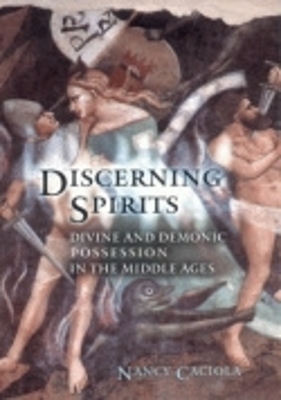
Discerning Spirits
Divine and Demonic Possession in the Middle Ages
Seiten
2003
Cornell University Press (Verlag)
978-0-8014-4084-7 (ISBN)
Cornell University Press (Verlag)
978-0-8014-4084-7 (ISBN)
Analyzes a broad array of sources—from saints' lives to medical treatises, exorcists' manuals to miracle accounts—to find that observers came to rely on the discernment of bodies rather than seeking to distinguish between divine and demonic possession in purely spiritual terms.
Trance states, prophesying, convulsions, fasting, and other physical manifestations were often regarded as signs that a person was seized by spirits. In a book that sets out the prehistory of the early modern European witch craze, Nancy Caciola shows how medieval people decided whom to venerate as a saint infused with the spirit of God and whom to avoid as a demoniac possessed of an unclean spirit. This process of discrimination, known as the discernment of spirits, was central to the religious culture of Western Europe between 1200 and 1500.
Since the outward manifestations of benign and malign possession were indistinguishable, a highly ambiguous set of bodily features and behaviors were carefully scrutinized by observers. Attempts to make decisions about individuals who exhibited supernatural powers were complicated by the fact that the most intense exemplars of lay spirituality were women, and the "fragile sex" was deemed especially vulnerable to the snares of the devil. Assessments of women's spirit possessions often oscillated between divine and demonic interpretations. Ultimately, although a few late medieval women visionaries achieved the prestige of canonization, many more were accused of possession by demons. Caciola analyzes a broad array of sources from saints' lives to medical treatises, exorcists' manuals to miracle accounts, to find that observers came to rely on the discernment of bodies rather than seeking to distinguish between divine and demonic possession in purely spiritual terms.
Trance states, prophesying, convulsions, fasting, and other physical manifestations were often regarded as signs that a person was seized by spirits. In a book that sets out the prehistory of the early modern European witch craze, Nancy Caciola shows how medieval people decided whom to venerate as a saint infused with the spirit of God and whom to avoid as a demoniac possessed of an unclean spirit. This process of discrimination, known as the discernment of spirits, was central to the religious culture of Western Europe between 1200 and 1500.
Since the outward manifestations of benign and malign possession were indistinguishable, a highly ambiguous set of bodily features and behaviors were carefully scrutinized by observers. Attempts to make decisions about individuals who exhibited supernatural powers were complicated by the fact that the most intense exemplars of lay spirituality were women, and the "fragile sex" was deemed especially vulnerable to the snares of the devil. Assessments of women's spirit possessions often oscillated between divine and demonic interpretations. Ultimately, although a few late medieval women visionaries achieved the prestige of canonization, many more were accused of possession by demons. Caciola analyzes a broad array of sources from saints' lives to medical treatises, exorcists' manuals to miracle accounts, to find that observers came to rely on the discernment of bodies rather than seeking to distinguish between divine and demonic possession in purely spiritual terms.
Nancy Caciola is Associate Professor of Medieval History at University of California, San Diego.
IntroductionPART I. "A PROTRACTED DISPUTATION"1. Possessed Behaviors
2. CiphersPART II: SPIRITUAL PHYSIOLOGIES3. Fallen Women and Fallen Angels
4. Breath, Heart, BowelsPART III. DISCERNMENT AND DISCIPLINE5. Exorcizing Demonic Disorder
6. Testing Spirits in the Effeminate AgeIndex
| Erscheint lt. Verlag | 4.9.2003 |
|---|---|
| Reihe/Serie | Conjunctions of Religion and Power in the Medieval Past |
| Verlagsort | Ithaca |
| Sprache | englisch |
| Maße | 155 x 235 mm |
| Gewicht | 907 g |
| Themenwelt | Sachbuch/Ratgeber ► Gesundheit / Leben / Psychologie ► Esoterik / Spiritualität |
| Geschichte ► Allgemeine Geschichte ► Mittelalter | |
| Geisteswissenschaften ► Geschichte ► Regional- / Ländergeschichte | |
| Geisteswissenschaften ► Religion / Theologie ► Weitere Religionen | |
| ISBN-10 | 0-8014-4084-X / 080144084X |
| ISBN-13 | 978-0-8014-4084-7 / 9780801440847 |
| Zustand | Neuware |
| Haben Sie eine Frage zum Produkt? |
Mehr entdecken
aus dem Bereich
aus dem Bereich
eine neue Geschichte des Mittelalters
Buch | Hardcover (2023)
C.H.Beck (Verlag)
CHF 53,20


